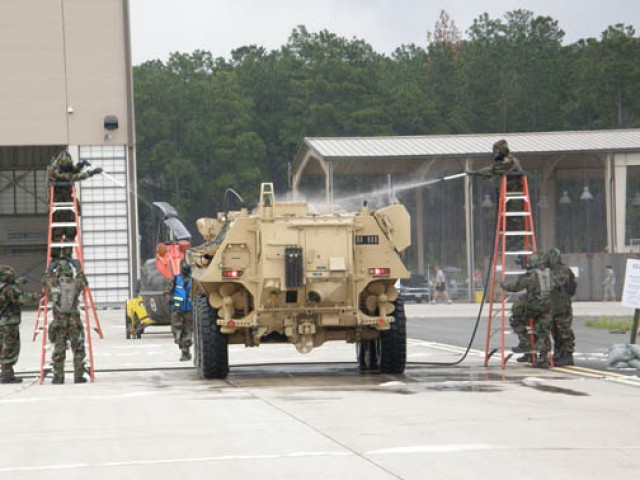FORT POLK, La. -- It's difficult to fight what you can't see. Advancements in technology result in fighting techniques that engage an enemy in ways other than face-to-face combat.
One of the more insidious evolutions is in chemical warfare. The ability to harm large numbers with nothing more than what seems to be a mad scientist's concoction of a few poisonous agents and something to propel them with can be frightening. Combating chemical attacks and their aftermath involves intense training, both physical and mental, in the proper way to handle dangerous chemical agents.
That's why Fort Polk's 51st Chemical Company, 83rd Chemical Battalion, performed decontamination training on aircraft and unit vehicles at Polk Army Airfield June 4.
According to 1st Lt. Gabriel Espinosa, officer in charge of the exercise and 2nd Platoon leader, the scenario for the training broke down like this: An individual is seen dropping suspicious looking vials at an off-post location. Aviators begin to feel nauseous and sick.
They believe a chemical incident has occurred and call for Fort Polk's support. That's where the expertise of Fort Polk's 51st Chem Co comes into action. "They call us in to provide possible aircraft decontamination. The aircraft we will be decontaminating in today's scenario are UH-1 and UH-58 helicopters," said Espinosa.
The decontamination team begins by sending the company's M-93 Fox reconnaissance vehicles in to conduct a survey of the airfield and confirm or deny any presence of contamination.
"The M-93 A1 Fox reconnaissance vehicles just redeployed from Kuwait in March. I'm excited that they are here. They are specifically used for chemical, biological, radiological, nuclear situations and reconnaissance. Before we occupy an area, we send in a Fox. They have expensive systems inside the vehicles that can detect chemical agents, so they can tell us if an area is clean," said
Capt. Jacy Parks, commander, 51st Chem Co. For this scenario's purpose, they confirm that no contamination is present at the airfield. They do detect a nerve agent on the aircraft.
Decontamination teams set up stations -- five in all -- to remove contamination that may be on the aircraft. Stations are set up exactly as they would be in a real situation.
Station one is a primary wash, station two is a decontamination application, station three is interior decontamination, station four is a rinse and station five is the check to make sure decontamination is successful. This is done with an Improvised Chemical Agent Monitor or ICAM. According to Espinosa, if this device detects any contamination on the vehicle, it has to go through the process again.
As far as the types of chemicals the company trains for, Parks said, "We try to research the deadliest, most persistent chemicals to deal with and then we train based on that information."
Decontamination set up is a time consuming process. "Generally speaking, we need about 40 minutes minimum for each vehicle. So, if you do a whole company of vehicles, you are talking about the decontamination unit being in MOPP (mission-oriented protective posture) gear for up to six to eight hours," said Parks. "Our guys are highly trained in MOPP gear but it adds about 10-15 degrees to your body. It can get as hot as 110-115 degrees in the gear if you are doing hard labor in the heat. People can begin to fall out," said Parks.
She said the vehicles and aircraft are expensive pieces of equipment that are important to the battle, so Soldiers should train to better perform their jobs. Parks said Soldiers should be in top physical shape by doing intense physical training.
This enables them to wear the gear longer and perform better when the scenario is real. "That's why we put emphasis on PT because it takes so much physical strength to accomplish our mission," said Parks.
There aren't many differences between the scenario at the airfield and what happens in Iraq. "Doctrinally, it's the same training whether we are decontaminating on post or while deployed," said Espinosa.
He said the importance of this training results in keeping Soldiers and their equipment in the mission. "Once vehicles have been decontaminated, it enables commanders to get their equipment back into the fight," said Espinosa.


Social Sharing